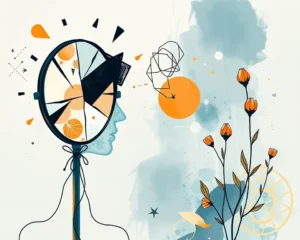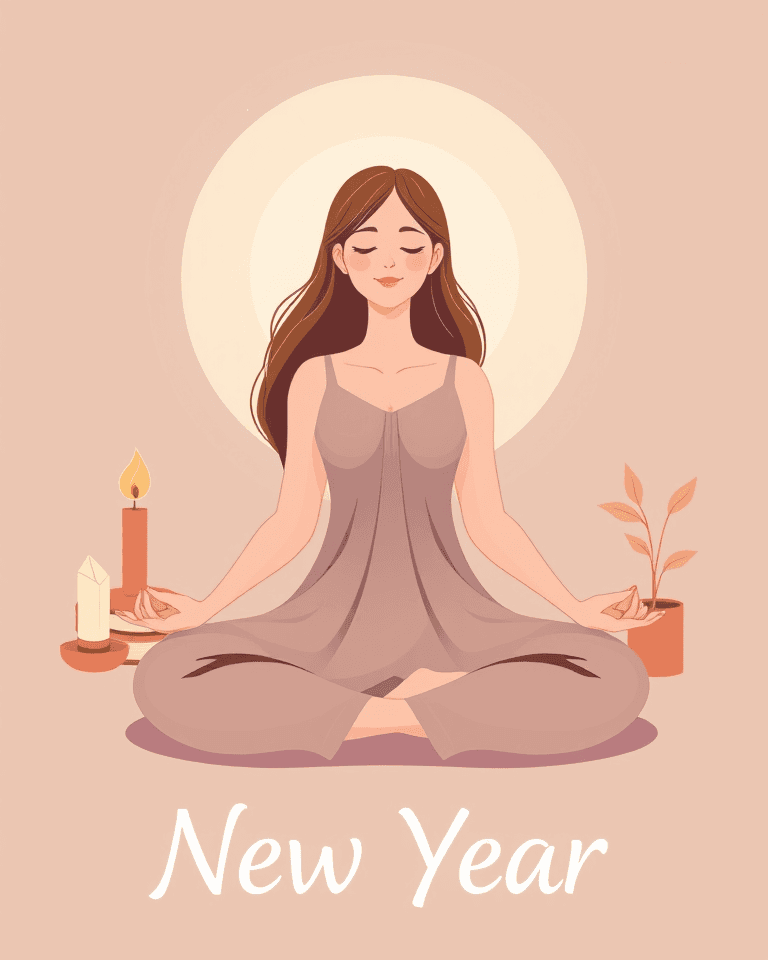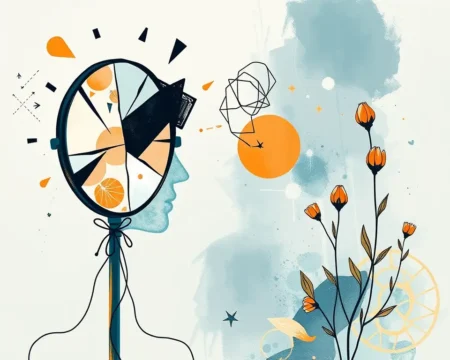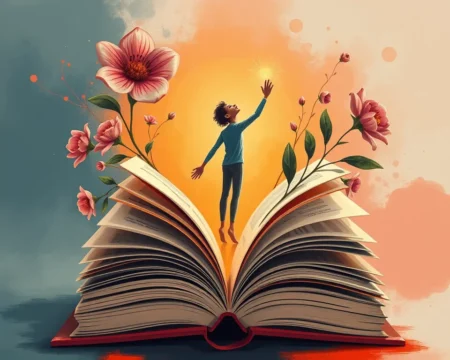As the new year begins, many people seek ways to improve their lives and well-being. Amidst the rush of resolutions and goals, the practice of mindfulness offers a powerful path to cultivate inner peace and resilience. Mindfulness, at its core, is the practice of being fully present in the moment, aware of your thoughts, feelings, and sensations without judgment. By integrating mindfulness into your daily life, you can reduce stress, enhance focus, and navigate the challenges of the new year with greater ease and clarity.
The Power of Mindfulness
Mindfulness is more than just a trendy concept; it’s a practice with significant benefits for mental and physical health. Research indicates that regular mindfulness practice can lead to a reduction in stress, anxiety, and depression. It works by reducing activity in the amygdala, the part of the brain responsible for triggering stress responses, thereby lowering overall stress levels. Furthermore, mindfulness meditation can improve attention, decrease job burnout, enhance sleep quality, and even improve diabetes control.
Key Benefits of Mindfulness
- Stress Reduction: Mindfulness helps manage racing and repetitive thoughts that lead to stress. By focusing on the present, you can break free from worrying about the future or dwelling on the past.
- Improved Focus: Regular practice enhances concentration and mental clarity, making it easier to stay focused on tasks and activities.
- Emotional Regulation: Mindfulness promotes a balanced approach to your thoughts and feelings, helping you develop healthier ways of responding to difficult emotions.
- Increased Self-Awareness: Mindfulness encourages you to connect with your inner self, fostering a better understanding of your emotions and reactions.
- Better Physical Health: Studies suggest that mindfulness can lower blood pressure, improve sleep, and even help manage chronic pain.
Mindfulness Techniques to Start Your Year
Embarking on a journey of mindfulness doesn’t require drastic changes. Here are several simple yet effective techniques to incorporate into your new year routine:
Mindful Breathing
Mindful breathing is a foundational technique in mindfulness practice. It involves focusing on the sensation of your breath entering and leaving your body.
- How to: Find a quiet place, sit or lie comfortably, and close your eyes. Direct your attention to your breath, noticing the rise and fall of your chest or abdomen. If your mind wanders, gently bring your focus back to your breath.
- Why It Works: Breathing exercises help slow down the body’s stress response, promoting a sense of calm and mental clarity.
Sensory Awareness
Our senses are always engaged, but often, we’re not fully aware of the experiences they provide. Practicing sensory awareness involves deliberately tuning into your senses.
- How to: Take a moment to fully experience your surroundings. Notice the colors, textures, and shapes you can see. Pay attention to the sounds around you. Be conscious of the smells and tastes you encounter. Feel the sensations of touch against your skin.
- Why It Works: Engaging your senses can ground you in the present moment, pulling you out of the cycle of thoughts and worries.
Walking Meditation
Moving mindfully can be just as beneficial as sitting meditation. Walking meditation combines physical movement with mindful awareness.
- How to: Find a quiet place, indoors or outdoors, and walk slowly. Focus on the sensation of each step, noticing how your feet feel on the ground and the movement of your body. Pay attention to your surroundings but prioritize the physical experience of walking.
- Why It Works: It helps you stay present and grounded, combining physical activity with mental awareness.
Mindful Eating
Eating is often an automatic, rushed activity, but with mindfulness, it becomes an opportunity for presence and enjoyment.
- How to: Before eating, pause and look at your food, noticing its colors and textures. Take a moment to appreciate the smells and flavors. Eat slowly, savoring each bite.
- Why It Works: Mindful eating heightens your appreciation for food and can help with digestion and healthy eating habits.
Body Scan Meditation
Body scan meditation involves bringing awareness to different parts of your body, noticing any sensations without judgment.
- How to: Lie down comfortably and close your eyes. Bring your attention to your toes, noticing any physical sensations. Slowly move your awareness through each part of your body, moving up from your feet all the way to the top of your head. If you encounter any tension or discomfort, simply observe them without reacting.
- Why It Works: This practice fosters self-awareness by connecting you with your physical state, and allows you to release tension by just noticing it.
Self-Help Tools and Resources for Mindfulness
In today’s digital age, there’s a wealth of resources to support your mindfulness practice. Here are some readily available tools to help you along your journey:
Mindfulness Apps
Mindfulness apps offer guided meditations, breathing exercises, and various tools for promoting relaxation and focus. Many have free versions, making them accessible for all.
- Calm: A popular app with guided meditations, sleep stories, and music for relaxation.
- Headspace: Known for its easy-to-follow meditations and animations, it’s great for beginners.
- Insight Timer: Offers a wide range of guided meditations and customizable sessions.
- Smiling Mind: A free app with guided meditations for all ages, including educators.
- The Mindfulness App: Designed to integrate mindfulness into your daily life with a variety of guided sessions.
- MyLife Meditation: Offers customized meditations based on your current emotional state.
Online Programs and Websites
Various online platforms and websites offer valuable resources for learning about and practicing mindfulness.
- Mindful.org: Provides numerous articles, guided meditations, and resources for a mindful life.
- UCLA Mindful Awareness Research Center: Offers guided meditations and educational materials.
- UC San Diego Center for Mindfulness: Provides guided audio and video meditations.
- Free Mindfulness Project: Offers a variety of free guided meditations for download.
- Greater Good Science Center: Features resources and articles on mindfulness, well-being and happiness.
Books and Guides
Many books explore the principles and practices of mindfulness, offering guidance and support.
- The Mindful Path to Self-Compassion by Christopher K. Germer provides a guide to self-compassion in mindfulness practice.
- The Headspace Guide to Meditation and Mindfulness by Andy Puddicombe, an accessible guide with practical tips.
- 10% Happier by Dan Harris offers a relatable perspective on mindfulness.
- The Power of Now by Eckhart Tolle provides a spiritual perspective on living in the present moment.
Integrating Mindfulness Into the New Year
The beginning of a new year is the perfect time to incorporate mindfulness into your life. Instead of setting resolutions focused on achieving new things, consider an intention to become more mindful of what you already have around you.
Tips for a Mindful New Year
- Set Intentions, Not Just Resolutions: Focus on setting intentions that align with your values.
- Start Small: Begin with short, daily mindfulness practices and gradually increase their duration.
- Create a Routine: Schedule time for mindfulness practice to make it a regular part of your day.
- Find a Quiet Space: Practice in a comfortable area where you will not be easily distracted.
- Be Patient: Mindfulness is a skill that takes time to develop. Be gentle with yourself and celebrate small victories.
- Use Visual Reminders: Place reminders in your environment to prompt you to be mindful.
- Cultivate Self-Compassion: Be kind and understanding to yourself, especially when you miss a practice or find it difficult.
By incorporating mindfulness into your daily life, you can enter the new year with a sense of calm, focus, and resilience. Whether you’re using guided meditations, practicing breathing exercises, or simply taking a moment to be fully present, mindfulness can enhance your well-being and bring greater joy to your life.










